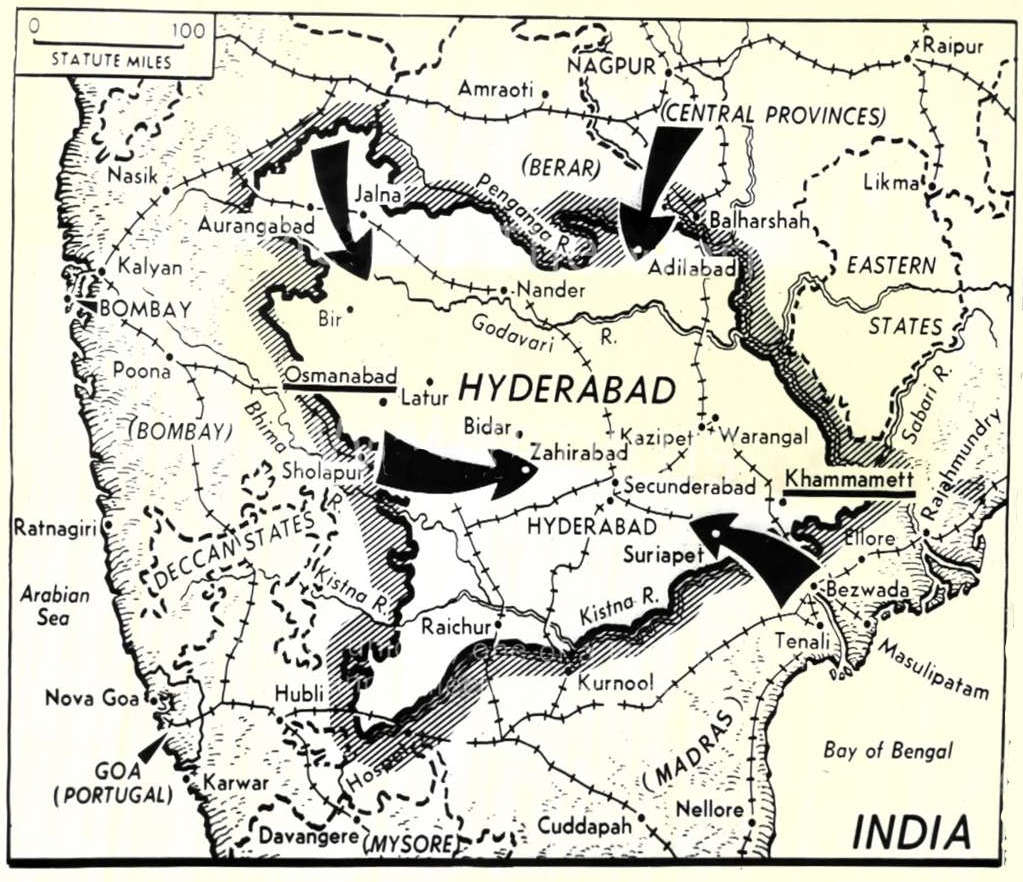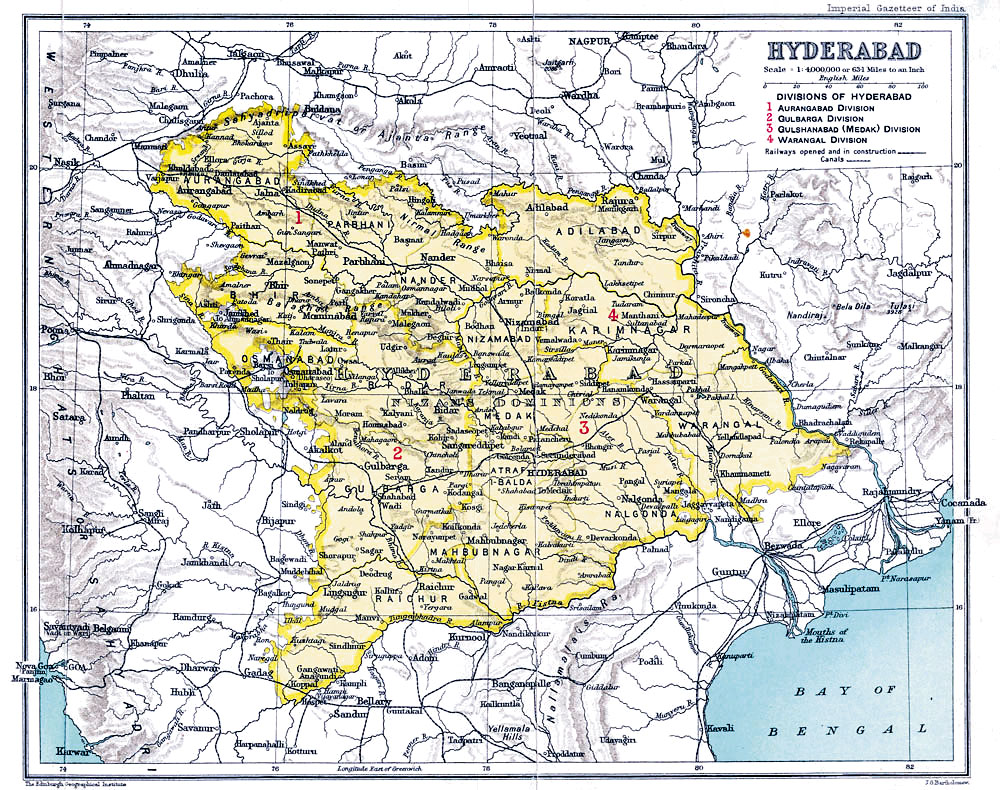|
Atraf-i-Baldah
Atraf-i-Baldah or just Atraf Baldah district was the capital of Hyderabad state. It consisted of seven talukas during the reign of the Nizams, rulers of Hyderabad State. The total revenue from the area went to the private purse of the Nizam known as Sarf-e-Khas. Atraf-i-Baldah meaning ''Suburbs of the City''. The area was distinct and was in direct control of the Nizams, outside this area was ruled by Jamindars, Jagirdars, landlords etc. Post Operation Polo After the annexation of Hyderabad state with Operation Polo on September 1948, some land was taken by the Army and the rest to the state provincial government. Division in Atraf-i-Balda district Hyderabad State was made up of sixteen districts. The districts were grouped into four divisions and Atraf-i-Baldah was part of Medak Gulshanabad Division – districts included Atraf-i-Balda (Hyderabad), Mahbubnagar, Medak, Nalgonda (Nalgundah), and Nizamabad districts. Atraf-i-Baldah Army The area was under Nizam's private army, A ... [...More Info...] [...Related Items...] OR: [Wikipedia] [Google] [Baidu] |
Sarf-e-Khas
Sarf-e-Khas are crown lands across the princely state of Hyderabad belonging to the Nizam family covering 10,000 square miles. The Dar-ul-Shifa was the headquarters for Sarf-e-Khas during the reign of Nizam II. Sarf-e-Khas land revenue and the resources were used to serve the royalty exclusively, until its merger with Indian Union in 1948. It was taken over by the Government of India after the accession and paid The Last Nizam and his family a sum of one crore per annum. The Nizam had a private army known as Sarf-e-Khas army. History Formerly the Diwani revenue officials were also responsible for the revenue collection of the Sarf-e-Khas lands within their jurisdiction, but during the time of His Highness Nasir-ud-Dowla Bahadur some territories were detached from the Dewani and taken under his personal management. The reason for this was the great irregularity that used to occur in making payments from the treasury, which, owing to the system of revenue collection at the time, ... [...More Info...] [...Related Items...] OR: [Wikipedia] [Google] [Baidu] |
Hyderabad State
Hyderabad State () was a princely state located in the south-central Deccan region of India with its capital at the city of Hyderabad. It is now divided into the present-day state of Telangana, the Kalyana-Karnataka region of Karnataka, and the Marathwada region of Maharashtra in India. The state was ruled from 1724 to 1857 by the Nizam, who was initially a viceroy of the Mughal empire in the Deccan. Hyderabad gradually became the first princely state to come under British paramountcy signing a subsidiary alliance agreement. During British rule in 1901 the state had an average revenue of Rs. 417,000,000, making it the wealthiest princely state in India. The native inhabitants of Hyderabad Deccan, regardless of ethnic origin, are called "Mulki" (countryman), a term still used today. The dynasty declared itself an independent monarchy during the final years of the British Raj. After the Partition of India, Hyderabad signed a standstill agreement with the new dominion of India ... [...More Info...] [...Related Items...] OR: [Wikipedia] [Google] [Baidu] |
Taluka
A tehsil (, also known as tahsil, taluka, or taluk) is a local unit of administrative division in some countries of South Asia. It is a subdistrict of the area within a district including the designated populated place that serves as its administrative centre, with possible additional towns, and usually a number of villages. The terms in India have replaced earlier terms, such as '' pargana'' (''pergunnah'') and ''thana''. In Andhra Pradesh and Telangana, a newer unit called mandal (circle) has come to replace the system of tehsils. It is generally smaller than a tehsil, and is meant for facilitating local self-government in the panchayat system. In West Bengal, Bihar, Jharkhand, community development blocks are the empowered grassroots administrative unit, replacing tehsils. As an entity of local government, the tehsil office (panchayat samiti) exercises certain fiscal and administrative power over the villages and municipalities within its jurisdiction. It is the ultimate execu ... [...More Info...] [...Related Items...] OR: [Wikipedia] [Google] [Baidu] |
Nizam
The Nizams were the rulers of Hyderabad from the 18th through the 20th century. Nizam of Hyderabad (Niẓām ul-Mulk, also known as Asaf Jah) was the title of the monarch of the Hyderabad State ( divided between the state of Telangana, Marathwada region of Maharashtra and Kalyana-Karnataka region of Karnataka). ''Nizam'', shortened from ''Nizam-ul-Mulk'', meaning ''Administrator of the Realm'', was the title inherited by Asaf Jah I. He was the former ''Naib'' (suzerain) of the Great Mughal in the Deccan, the premier courtier of Mughal India until 1724, the founding of an independent monarchy as the " Nizam (title) of Hyderabad". The Asaf Jahi dynasty was founded by Mir Qamar-ud-Din Siddiqi (Asaf Jah I), who served as a ''Naib'' of the Deccan sultanates under the Moghul Empire from 1713 to 1721. He intermittently ruled the region after Emperor Aurangzeb's death in 1707. In 1724 Mughal control weakened, and Asaf Jah became virtually independent of the Mughal Empire; Hyd ... [...More Info...] [...Related Items...] OR: [Wikipedia] [Google] [Baidu] |
Hyderabad State
Hyderabad State () was a princely state located in the south-central Deccan region of India with its capital at the city of Hyderabad. It is now divided into the present-day state of Telangana, the Kalyana-Karnataka region of Karnataka, and the Marathwada region of Maharashtra in India. The state was ruled from 1724 to 1857 by the Nizam, who was initially a viceroy of the Mughal empire in the Deccan. Hyderabad gradually became the first princely state to come under British paramountcy signing a subsidiary alliance agreement. During British rule in 1901 the state had an average revenue of Rs. 417,000,000, making it the wealthiest princely state in India. The native inhabitants of Hyderabad Deccan, regardless of ethnic origin, are called "Mulki" (countryman), a term still used today. The dynasty declared itself an independent monarchy during the final years of the British Raj. After the Partition of India, Hyderabad signed a standstill agreement with the new dominion of India ... [...More Info...] [...Related Items...] OR: [Wikipedia] [Google] [Baidu] |
Jamindar
A zamindar ( Hindustani: Devanagari: , ; Persian: , ) in the Indian subcontinent was an autonomous or semiautonomous ruler of a province. The term itself came into use during the reign of Mughals and later the British had begun using it as a native synonym for “estate”. The term means ''land owner'' in Persian. Typically hereditary, from whom they reserved the right to collect tax on behalf of imperial courts or for military purposes. During the period of British colonial rule in India many wealthy and influential zamindars were bestowed with princely and royal titles such as ''maharaja'' (great king), ''raja/rai'' (king) and ''nawab''. During the Mughal Empire, zamindars belonged to the nobility and formed the ruling class. Emperor Akbar granted them mansabs and their ancestral domains were treated as jagirs. Some zamindars who were Hindu by religion and brahmin or kayastha or kshatriya by caste were converted into Muslims by the Mughals. During the colonial era, the P ... [...More Info...] [...Related Items...] OR: [Wikipedia] [Google] [Baidu] |
Operation Polo
Operation Polo was the code name of the Hyderabad "police action" in September 1948, by the then newly independent Dominion of India against Hyderabad State. It was a military operation in which the Indian Armed Forces invaded the Nizam-ruled princely state, annexing it into the Indian Union. At the time of Partition in 1947, the princely states of India, who in principle had self-government within their own territories, were subject to subsidiary alliances with the British, giving them control of their external relations. With the Indian Independence Act 1947, the British abandoned all such alliances, leaving the states with the option of opting for full independence. However, by 1948 almost all had acceded to either India or Pakistan. One major exception was that of the wealthiest and most powerful principality, Hyderabad, where the Nizam, ''Mir'' Osman Ali Khan, Asaf Jah VII, a Muslim ruler who presided over a largely Hindu population, chose independence and hoped to mai ... [...More Info...] [...Related Items...] OR: [Wikipedia] [Google] [Baidu] |
Medak Gulshanabad Division
Medak Gulshanabad Division was administratively part of the Hyderabad State was made up of sixteen districts. Gulshanabad was one of four divisions which included Mahbubnagar district, Medak district, Nalgonda district (Nalgundah), and Nizamabad district. History Medak Gulshanabad Division was part of Bidar division, and was formed in 1905. Districts * Mahbubnagar district * Medak district * Nalgonda district Nalgonda district is a district in the Telangana state of India. Nalgonda district has the highest number of mandals in the state with 31 mandals. The district shares boundaries with Suryapet, Rangareddy, Yadadri and Nagarkurnool districts ... (Nalgundah) * Nizamabad district References {{Divisions of British India Hyderabad State ... [...More Info...] [...Related Items...] OR: [Wikipedia] [Google] [Baidu] |
Nizam's Guaranteed State Railway
Nizam's Guaranteed State Railway (NGSR) was a railway company operating in India from 1879 to 1950. It was owned by the Nizams of Hyderabad State, and its full name was ''His Exalted Highness, The Nizam's Guaranteed State Railway''. The company began with a line built privately by the HEH, the Nizam, which was owned and operated by the company under a guarantee from the Hyderabad State, much to the dismay of the British authorities. Capital for the line was raised by issuing redeemable mortgage debentures. The Nizam's railway was eventually consolidated with the Hyderabad-Godavari Valley Railway (HGVR). In 1951, both the NGSR and the HGVR were nationalised and merged into Indian Railways. History Nizam's Guaranteed State Railway As Hyderabad was one of the largest princely states of India, the 6th Nizam of Hyderabad wanted to build a railway line to connect his realm with the rest of British India (now India). The proposal was for an initial railway line to be built ... [...More Info...] [...Related Items...] OR: [Wikipedia] [Google] [Baidu] |
Hyderabad-Godavari Valley Railways
Nizam's Guaranteed State Railway (NGSR) was a railway company operating in India from 1879 to 1950. It was owned by the Nizams of Hyderabad State, and its full name was ''His Exalted Highness, The Nizam's Guaranteed State Railway''. The company began with a line built privately by the HEH, the Nizam, which was owned and operated by the company under a guarantee from the Hyderabad State, much to the dismay of the British authorities. Capital for the line was raised by issuing redeemable mortgage debentures. The Nizam's railway was eventually consolidated with the Hyderabad-Godavari Valley Railway (HGVR). In 1951, both the NGSR and the HGVR were nationalised and merged into Indian Railways. History Nizam's Guaranteed State Railway As Hyderabad was one of the largest princely states of India, the 6th Nizam of Hyderabad wanted to build a railway line to connect his realm with the rest of British India (now India). The proposal was for an initial railway line to be built ... [...More Info...] [...Related Items...] OR: [Wikipedia] [Google] [Baidu] |






